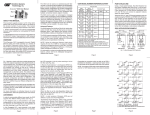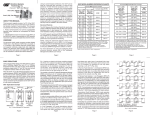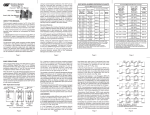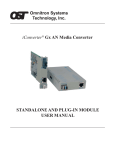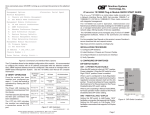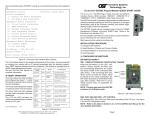Download Omnitron iConverter GX/T
Transcript
OVERVIEW The iConverter GX/T provides 10/100/1000BASE-T UTP to 1000BASE-X Fiber conversion as well as rate conversion between 10BASE-T, 100BASE-TX, 1000BASE-T and 1000BASE-SX/LX. Models are available for multimode (MM) and single-mode (SM) dual fiber, and single-mode single-fiber (SF). ® iConverter GX/T User Manual Port 1 (P1) The GX/T UTP port supports Half-Duplex and FullDuplex modes and features an automatic crossover mode for easy attachment to hubs, switches and workstations. Port 2 (P2) iConverter GX/T Dual Fiber Modules Connector Type Fiber Type Distance SC MT-RJ LC MM 220m / 550m1 8522-0 8524-0 SM 12 km 8523-1 8525-1 8527-1 SM 34 km 8523-2 - 8527-2 80 km 8523-3 - 8527-3 SM 8526-0 iConverter GX/T Single-Fiber Modules Fiber / Connector Type Tx: 1310nm, Tx: 1550nm, Distance Rx: 1550nm Rx: 1310nm SM / SC 20 km 8530-1 8531-1 SM / SC 40 km 8530-2 8531-2 The GX/T can be used as a standard two-port UTP to fiber converter. It can also use its two additional 10/100 backplane ports to connect to adjacent modules and accommodate flexible network configurations. The iConverter 19-Module, 5-Module or 2-Module Chassis have backplanes that facilitate connectivity between adjacent modules. The GX/T can be used in a managed or unmanaged application. When managed, it must be installed in a chassis with an iConverter Network Management Module (NMM), GX/TM or 10/100M. ADVANCED FEATURES The GX/T features Port VLAN and Tag VLAN, which allow complete control of traffic flow between the front-plane UTP port, the fiber port and the chassis backplane ports. The GX/T also features Port Access Control, which facilitates enabling and disabling of individual ports. It also supports reporting of MIB statistics. For wide temperature (-40 to 60º C), add a "W" to the end of the model number. Consult factory for extended temperature (-40 to 75º C) models. LS In Link Segment (LS), a port transmits a Link signal independently of any received Link at any other port. For example, the UTP transmits a Link regardless of the fiber receiving a Link [Fig. 2(a) & (b)]. In Link Propagate (LP), a port transmits a Link signal only when receiving a Link at its other port. For example, the UTP transmits a Link only when receiving a Link at the fiber port [Fig. 2(c)]. In Remote Fault Detection + Link Segment (RFD+LS), the fiber port transmits a Link signal only when receiving a Link at the fiber port. As a result, fiber faults (no Link received at the fiber) are looped-back and can be reported to the network core [Fig. 2(d)]. In Remote Fault Detection + Link Propagate (RFD+LP), the UTP port transmits a Link signal only when receiving a Link at the fiber port. The fiber port transmits a Link signal only when receiving Link signals at both the fiber port and the UTP port. As a result, fiber faults (no Link received at the fiber) are propagated forward and looped back for fault reporting at both the network core and the customer location [Fig. 2(e)]. NOTE: Connecting two converters with both set to RFD mode is not supported and will cause a “deadly embrace” lockup. PORT STRUCTURE Using a 4-port switch design, the GX/T features two front-plane ports (1000Mbps fiber Port 1 and a 10/100/1000 UTP Port 2) and two 10/100 Ethernet backplane ports (A and B) that can connect to adjacent modules within the same chassis. When the GX/T backplane A and B ports are enabled (using “BPAEN” and “BPBEN” DIP-Switches), they connect via the chassis backplane to the slots on the left and right sides of the GX/T module. When another switch-based module with backplane port connections (such as a second GX/T or an NMM) is installed in an adjacent slot, it can be connected via the backplane to the GX/T to facilitate a multi-module configuration. GX/T Application Example: Fig. 1 depicts a chassis with three modules plugged into three adjacent backplane slots (beginning with an odd numbered slot). The adjacent slots are connected via the backplane using the A and B 10/100 links. In this example, the GX/T in the center slot connects to the slot on its left using the A link and the slot on its right using the B link. (a) Switch 1 Fiber LS UTP UTP Fiber Converter A Converter B LS LS Switch 2 (b) Switch 1 Converter A LP Converter B LP Switch 2 Converter A LP Converter B RFD+LS Switch 2 Converter A LP Converter B RFD+LP Switch 2 (c) Switch 1 (d) Switch 1 Switch 1 Converter A SFD Converter B SFD Switch 2 (f) Switch 1 Converter A Converter B Switch 2 LED Lit LED Blinking LED Off LED Status depends on connected device Page 6 In Symmetrical Fault Detection (SFD), the UTP port transmits a Link signal only when receiving a Link at the fiber port. The fiber port transmits a Link signal only when receiving a Link signal at both the fiber port and the UTP port. As a result, fiber faults (no Link received at the fiber) are looped back and can be reported to the network core. In addition, connecting two back-to-back converters which are both set to SFD facilitates dual-loop-back, where fiber faults are reported to both ends of the network. A blinking fiber link LED on a converter indicates a fault of the transmit fiber or UTP cables of that converter [Fig. 3(f)]. A Port “A” Link B Port NMM front / back select Slot 2 (even) A Port B Port Internal 10/100/1000 switch chip NMM UTP 10 port NMM Module Slot 3 (odd) “B” Link A Port B Port Internal 10/100 switch chip UTP Fiber 4-port 10/100 UTP 1000 port 10/100/1000 port Switch GX/T Module 4Tx Module Fig. 1 In-Band Managed GX/T Application In this example, the module on the left is a Network Management Module (NMM), connecting via its A backplane port to the GX/T, facilitating In-Band management (via the fiber uplink). The module on the right is a 4-port 10/100 switch module, connecting via its B link port to the GX/T, facilitating a 1-Port GX/T and a 4-Port 10/100 Ethernet switch with a fiber uplink configuration. This 3-module configuration provides an effective 10/100/1000 UTP to 4-Port 10/100 managed switch with a gigabit fiber uplink configuration. This example shows how the GX/T can be used either as a traditional managed or unmanaged media converter, or to create flexible and effective network switch configurations. Link Segment/Link Propagate “LS/LP” DIP-Switch This DIP-Switch controls the Link Propagate or Link Segment modes. When the DIP-Switch is in the “LS” position (factory setting), Link Segment mode is enabled. In the “LP” position, Link Propagate mode is enabled. Remote Fault Detection “RFD” DIP-Switch When in the “RFD” position, the Remote Fault Detection mode is enabled. Set the board-mounted Port 1 DIP-Switch to Manual Mode “MAN” for this feature. NOTE: Converters in SFD mode must be deployed in pairs. NOTE: Connecting two converters with both set to RFD mode is not supported and will cause a “deadly embrace” lockup. Fiber set to Auto-Negotiation Mode Symmetrical Fault Detection “SFD” DIP-Switch When the Fiber is set to Auto-Negotiation Mode, the device receiving the fault acts as if it is in RFD mode. Link Segment, Link Propagate and Symmetrical Fault Detection modes operate in the same manner (refer to Fig. 2(d), (e) and (f). When this DIP-Switch is in the “SFD” position, the Symmetrical Fault Detection mode is enabled. When in the “Off” position (factory setting), the Symmetrical Fault Detection mode is disabled. NOTE: “Remote Fault Detection” (RFD) is not a valid mode when the fiber is set to Auto-Negotiation. The user should select LS, LP or SFD instead. (e) Slot 1 (odd) Chassis Backplane For more information about individual chassis A and B backplane links, please refer to the specific chassis user manual. Page 4 Page 3 Fig. 2 GX/T Link Modes Page 5 For more information on using and configuring these advanced features, please refer to the NetOutlook Management Software user manual. Page 2 LINK MODES In order to accommodate different user needs, the GX/T supports five different linking modes (see Fig. 2). NOTE: Using the advanced features listed above requires the use of the Network Management Module (NMM) and the NetOutlook™ Management Software (or third-party SNMP management software) or Telnet. DIP-SWITCH SETTINGS Front Panel DIP-Switch Settings Link Segment = LS Off Off Straight-Through = LP = RFD = SFD = = Link Propagate Remote Fault Detect Symmetrical Fault Detect Crossover NOTE: Converters in SFD mode must be deployed in pairs. RJ-45 Manual Crossover “= / X” DIP-Switch When the board-mounted Manual Crossover Enable DIP-Switch is set to “MANX,” the front panel RJ-45 Manual Crossover Switch is enabled. When connecting the UTP to a hub or switch, set the front panel switch to Straight-Through “=” (factory setting). When connecting to a workstation, set it to Crossover “X.” Only use this setting with 10T or 100Tx mode. Fig. 3 Front Panel DIP-Switches Page 7 Page 8 BOARD MOUNTED DIP-SWITCHES ON P1 Auto Negotiate P2 Auto Negotiate P2 Full Duplex UTP 100Mbps UTP 1000Mbps Auto Crossover Off Off = AN = AN = FD = 100 = 1000 = AX BPAEN = BPBEN = MAN = MAN = = HD 10 = 10-100 = MANX = Backplane “A” Enabled Backplane “B” Enabled P1 Manual FO P2 Manual UTP P2 Half Duplex UTP 10Mbps UTP 10/100Mbps Manual Crossover Fig. 4 Board Mounted DIP-Switches Backplane A Enable DIP-Switch (BPAEN) When the “BPAEN” DIP-Switch is in the “ON” position (right), the iConverter GX/T module A backplane Ethernet port is enabled. This port allows connectivity to an adjacent module. When the “BPAEN” DIP-Switch is in the “Off” position (left, factory setting), the A port is isolated from the backplane. Backplane B Enable “BPBEN” DIP-Switch When the Backplane B Enable “BPBEN” DIP-Switch is in the “ON” position (right), the iConverter GX/T module B backplane Ethernet port is enabled. This port allows connectivity to an adjacent module. When the “BPBEN” DIP-Switch is in the “Off” position (left, factory setting), the B port is isolated from the backplane. NOTE: When the fiber port is in Manual Mode, sometimes a link-up will not occur with other devices. Both devices must be set to the same mode (either Manual or Auto-Negotiate) for the link-up to occur. UTP Auto/Manual P2 “AN/MAN” DIP-Switch Setting the P2 Auto/Manual Negotiate DIP-Switch to Auto-Negotiate “AN” (factory setting) enables the UTP port to determine the speed and duplex mode automatically. If the connected device cannot provide the proper signal to indicate its own mode of operation, this DIP-Switch should be set to P2 Manual “MAN.” This feature allows connections with devices that do not auto-negotiate properly. NOTE: Attaching an auto-negotiating UTP port to a non auto-negotiating (manual/forced/hard-coded) UTP port may result in an unpredictable port setting with excessive collisions and poor link performance. When operating in manual mode, both mating ports MUST be set manually to the same speed and duplex mode. Gigabit devices typically function only in Auto-Negotiate Mode. 1000 Manual Mode is not a valid mode and will result in an undefined response. Use Manual mode only when selecting the 10 or 100 mode. Fiber Auto/Manual P1 “AN/MAN” DIP-Switch UTP Full/Half-Duplex P2 “FD/HD” DIP-Switch Setting this DIP-Switch to P1 Auto-Negotiate “AN” (factory setting) enables the Fiber Port to determine duplex mode automatically. If the connected device cannot provide the proper signal to indicate its own mode of operation, this DIP-Switch should be set to P1 Manual “MAN.” This feature allows connections with devices that do not auto-negotiate properly. When the UTP P2 Auto/Manual DIP-Switch (described above) is in the P2 Manual “MAN” position, the UTP P2 Full/Half Duplex “FD/HD” DIP-Switch selects the duplex mode for the UTP port. When set to Full-Duplex “FD” (factory setting), the UTP port operates in Full-Duplex mode. When P2 is set to Half-Duplex “HD,” the UTP port operates in Half-Duplex mode. Page 9 Page 10 LED INDICATORS LED Pwr: Fiber FDX: Lk/Act AN: 10: 100: 1000: UTP FDX: Color Yellow Green Green Green Green Green Green Green Model Type Description On--Power / Blink--test On--Full-Duplex detected On--Link / Blink--activity On--UTP Auto-Neg. enabled On--10 Mbps link / Blink-activity On--100 Mbps link / Blink-activity On--1000 Mbps link / Blink-activity On--Full-Duplex detected Mounting and Cable Attachment iConverter modules are hot-swappable and can be installed into any chassis in the iConverter family. 1. Carefully slide the iConverter module into the installation slot, aligning the module with the installation guides. NOTE: Ensure that the module is firmly seated against the backplane. 2. Secure the module by securing the panel fastener screw (attached to module) to the chassis front. 3. Attach the UTP port via a category 5 cable to a 1000BASE-T, 100BASE-TX or 10BASE-T Ethernet device. 4. Attach the fiber port via an appropriate multimode or single-mode fiber cable to a 1000BASE-X Ethernet device. The iConverter transmit (Tx) must attach to the receive side on other device; the receive (Rx) must attach to the transmit. 5. When using single-fiber (SF) media converter models, the Tx wavelength on one end has to match the Rx wavelength on the other. Note that based on this guideline, the SF media converter models must be used in pairs, such as the 8530-1 matched with the 8531-1. Protocols UTP Connectors Fiber Connectors Controls LED Displays Dimensions Weight When the UTP P2 Auto/Manual DIP-Switch is in the Auto-Negotiate “AN” position and the “10-100/1000” DIP-Switch (described below) is set to “10-100,” the “10/100” DIP-Switch determines the highest speed of the UTP P2 port in the following manner: When the “10/100” DIP-Switch is set to the “100” position, P2 operates at 100Mbps or less, depending on the speed of the connected device. When the “10/100” DIP-Switch is set to the “10” position, P2 operates only at 10Mbps. When the UTP P2 Auto/Manual DIP-Switch is in the Manual “MAN” position and the UTP “10-100/1000” DIP-Switch (described below) is set to “10-100,” the “10/100” DIP-Switch determines the speed of the UTP P2 port. When set to “100” (factory setting), the UTP port will operate at 100Mbps. When set to “10,” the UTP port will operate at 10Mbps. GX/T 10BASE-T, 100BASE-TX, 1000BASE-T, 1000BASE-SX/LX RJ-45 SC, MT-RJ, LC, Single-Fiber SC BP Enable, X-Over, LS/LP, RFD, SFD, UTP Auto/Man, 10/100/1000, UTP FDX/HDX, F/O Auto/Man Power, FO link, UTP link, Auto, FDX/HDX, 10/100/1000 W:0.85" x D:4.5" x H:2.8" 8 oz. UL, CE, FCC Class A Power Requirement 1.4A @ 3.3VDC (typical) Temperature Standard: Wide: Storage: 0 to 50º C -40 to 60º C -40 to 80º C Humidity 5 to 95% (non-condensing) Altitude -100m to 4000m NOTE: Setting the “10-100/1000” DIP-Switch to the “1000” position when in Manual mode is not permitted (per the IEEE 802.3 standard) and will result in unpredictable port behavior. Auto/Manual Crossover Enable P2 “AX/MANX” DIP-Switch When the Manual/Auto Crossover Enable DIP-Switch is set to Auto Crossover “AX” (factory default), the front panel crossover switch is disabled and the RJ-45 crossover is selected automatically. When it is set to Manual Crossover “MANX,” the front panel RJ-45 Manual Crossover DIP-Switch is enabled to allow a manual setting in either Crossover or Straight-Through connection. UTP 10-100/1000 P2 “10-100/1000” DIP-Switch When the P2 “AN/MAN” DIP-Switch is set to the Auto-Negotiate “AN” position, the “10-100/1000” DIP-Switch operates in the following manner: When set to “1000,” P2 operates at 1000Mbps or less, depending on the speed of the connected device. When set to the “10-100” position, the speed is selected by the UTP “10/100” DIP-Switch. When the P2 “AN/MAN” DIP-Switch is set to Manual “MAN” mode, the “10-100/1000” DIP-Switch must be set to the “10-100” position and the speed is selected by the “10/100” DIP-Switch. Page 11 Compliance MTBF (hrs) UTP 10/100 P2 “10/100” DIP-Switch Page 12 Warning Exclusive Remedies The operating description in this Instruction Manual is for use by qualified personnel only. To avoid electrical shock, do not perform any servicing of this unit other than that contained in the operating instructions, unless you are qualified and certified to do so by Omnitron Systems Technology, Inc. The remedies provided herein are the Buyer’s sole and exclusive remedies. Omnitron shall not be liable for any direct, indirect, special, incidental, or consequential damages, whether based on contract, tort, or any legal theory. Warranty This product is warranted to the original purchaser against defects in material and workmanship for a period of TWO YEARS from the date of shipment. A LIFETIME warranty may be obtained by the original purchaser by REGISTERING this product with Omnitron within 90 days from the date of shipment. TO REGISTER, COMPLETE AND MAIL OR FAX THE ENCLOSED REGISTRATION FORM. Or you may register your product on the Internet at www.omnitron-systems.com. During the warranty period, Omnitron will, at its option, repair or replace a product which is proven to be defective. For warranty service, the product must be sent to an Omnitron designated facility, at Buyer’s expense. Omnitron will pay the shipping charge to return the product to Buyer’s designated US address using Omnitron’s standard shipping method. Limitation of Warranty The foregoing warranty shall not apply to defects resulting from improper or inadequate use and/or maintenance of the equipment by Buyer, Buyersupplied equipment, Buyer-supplied interfacing, unauthorized modifications or tampering with equipment (including removal of equipment cover by personnel not specifically authorized and certified by Omnitron), or misuse, or operating outside the environmental specification of the product (including but not limited to voltage, ambient temperature, radiation, unusual dust, etc.), or improper site preparation or maintenance. No other warranty is expressed or implied. Omnitron specifically disclaims the implied warranties of merchantability and fitness for any particular purpose. 830,000 Page 15 TECHNICAL SUPPORT: For help with this product, contact our Technical Support: Phone: (949) 250-6510 Fax: (949) 250-6514 Address: Omnitron Systems Technology, Inc. 140 Technology Dr., #500 Irvine, CA 92618 USA E-mail: [email protected] URL: www.omnitron-systems.com Form: 040-08520-001E 9 /07 Page 16


